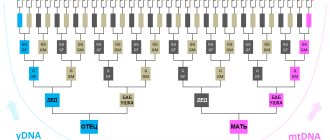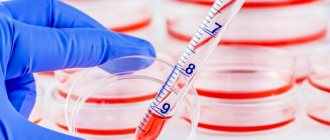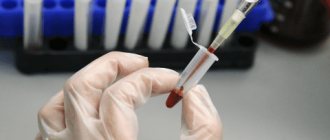Methods for detecting Helicobacter pylori
Today, there are several diagnostic methods that can detect the presence of Helicobacter bacteria in the body. First of all, you can perform an FGDS or fibrogastroduodenoscopy. During this procedure, the doctor uses an endoscope to examine the stomach and capture a tiny piece of tissue from the mucous membrane - the so-called biopsy - for further histological examination. It is studied under a microscope or using a special test system to detect the presence of Helicobacter pylori. This is the so-called invasive research method.
In addition, Helicobacter infection can be detected using a blood test. The thing is that in the presence of this bacterium, the production of special antibodies-immunoglobulins begins. They can be detected during enzyme immunoassay. You can also determine whether the bacterium is present in the body using the polymerase chain reaction method to detect a DNA fragment of the bacterium in the stool. This bacteriological analysis determines the presence of parasites extremely accurately
However, recently another method of detecting infection has become particularly popular - the Helicobacter breath test. This is a quick, simple and non-traumatic procedure for the patient, with highly accurate results.
Ways of infection with Helicobacter
Helicobacteriosis is an intestinal infection caused by the specific bacterium Helicobacter pylori.
The specificity of this bacterium is determined by its habitat. It is no secret that the human body is home to many bacteria and viruses. All of them parasitize under favorable conditions created by the human body.
For reference. But only the bacterium Helicobacter pylori is able to live in the acidic environment of the stomach. In direct contact with oxygen it dies.
Almost any person can develop helicobacteriosis. According to medical statistics, Helicobacter bacteria live in 95% of the population. They can live with a person his entire life without complications. And only under certain conditions (usually with a decrease in immunity) can uncontrolled inflammation (helicobacteriosis) of the gastric or duodenal mucosa develop, which can develop into gastritis or an ulcer.
In persons infected with Helicobacter, stomach cancer develops several times more often. The risk of cancer increases significantly due to the presence of a large number of long-term non-healing ulcers and erosions on the mucous membrane.
For reference. The bacterium is capable of releasing strong toxins that cause inflammation of the gastric mucosa and its rejection. In some cases, the microorganism provokes a decrease in the synthesis of gastric juice. This leads to atrophy of the gastric mucosa.
The bacterium Helicobacter pylori can enter the human body in 3 ways:
- Fecal-oral. Bacteria present in the stool of a sick person enter a healthy body through the oral cavity. Penetration can be accomplished through food, water;
- Oral-oral. Infection occurs through kissing through saliva. Children from sick parents can also get the disease through spoons and forks;
- Iatrogenic. It is very rare, but there are cases of infection with Helicobacter pylori through medical instruments used during examination of the gastrointestinal tract.
And although in most cases, infection with this type of intestinal infection occurs from humans, this infection can also penetrate through pets, dogs, pigs or cats.
When favorable conditions for reproduction appear in the form of stress or decreased immunity, the infection actively begins to reproduce, provoking the development of pathologies in the gastrointestinal tract.
When is it worth testing for Helicobacter?

It is worth conducting a test for the presence of the bacterium Helicobacter Pylori in the body for any manifestations of problems with the digestive system. The following symptoms should alert you:
- frequent heartburn, belching of air or food;
- feeling of discomfort, heaviness, pressure in the stomach after eating;
- nausea after eating even in the absence of errors in the diet;
- aversion to meat food;
- sudden signs of metabolic disorders: brittle nails, increased hair loss, dry and flaky skin, unexpected allergic reactions.
In addition, it is mandatory to conduct a test for Helicobacter if this infection has been identified in one of your family members, as well as in diseases such as gastritis, peptic ulcer, gastroduodenitis. Only after diagnosis, the doctor can prescribe treatment that will prevent the development of severe complications caused by Helicobacter infection. Please note that you cannot delay treatment, since the lack of therapy can lead to complications of diseases caused by this bacterium, namely gastric bleeding, perforation and penetration of ulcers, as well as malignant degeneration of erosions and ulcers.
Who needs to get tested for Helicobacter
For reference. The bacterium Helicobacter pylori is a parasite that lives in the stomach or duodenum.
They can become infected within a family or in groups where children and adults communicate closely and do not follow hygiene rules. Infection occurs through saliva, mucus, and when using the same utensils. This disease is called Helicobacteriosis.
Sometimes a person may not even suspect that these bacteria already live in his body until the development of diseases is triggered by stress, poor diet, alcohol abuse, smoking, etc. According to statistics, more than 70% of people over 40 years of age are carriers of Helicobacter pylori, but those infected do not experience symptoms of the disease.
If a person is weakened, then bacteria begin to multiply rapidly and release toxins, which, accumulating in large quantities, affect the mucous membrane of the internal organs. Inflammation appears first. If you do nothing, erosions or ulcers will soon appear, and tumors may also make themselves felt.
For reference. Anyone can take a test for Helicobacter pylori, but doctors prescribe it for those who already suffer from stomach or duodenal ulcers, gastritis, or if these bacteria were found in one of the family members (living with them), or in a loved one a relative was diagnosed with stomach cancer.
Also, the attending physician may be alerted by the following symptoms, in the presence of which he will be asked to take a test for Helicobacter:
- The patient suffers from heaviness in the stomach.
- It is difficult for him to digest protein foods, i.e. eat meat.
- He developed heartburn, flatulence, belching, and often felt sick and vomited.
- The stomach hurts, the pain subsides if a person has eaten.
- The patient complains of loss of appetite or difficulty swallowing.
- The man has lost a lot of weight.
- He has constant constipation or diarrhea.
Advantages and disadvantages of the breath test
The so-called breath (or respiratory) test for Helicobacter is absolutely safe and non-invasive, which is important for patients with increased lability of the nervous system. In addition, the result of the study will be ready quite quickly. And the most important advantage of a respiratory test is its high accuracy. The reliability of the results is 90-95%.
However, this research method has no contraindications. However, it should be borne in mind that a breath test for Helicobacter will be reliable only if properly prepared for it.
Analysis of test results
The reliability of the Helicobacter test has been confirmed by many experiments. The accuracy of the indicators is within the range of 75-97%. In addition, a lot depends on the equipment on which the test is carried out, as well as on the qualifications of the doctor himself. The big advantage of this test is that its results become known almost immediately after the procedure is completed. In all other cases, when data is analyzed by a mass spectrograph in a laboratory, the patient can wait up to 10 days for test results.
The lower the percentage of ammonia and carbon dioxide determined as a result of the test analysis, the lower the likelihood that this person will develop an ulcer or gastritis. If the concentration of indicator gases exceeds 15 ppm, then this indicates that the human body is quite severely affected by Helicobacter Pylori bacteria.
How to prepare for research
In order for the result of a breath test for the presence of Helicobacter Pylori in the body to be reliable, a number of rules must be followed.
- the study should be carried out exclusively in the morning, on an empty stomach. Please note that on the eve of the planned diagnosis, the stomach should not be overloaded. Dinner should be very light;
- if you are very thirsty, then no later than an hour before the test, you can drink no more than 100 ml of water;
- you should stop drinking alcohol three days before the study;
- the day before the test, exclude legumes from your diet;
- You must not smoke for four hours before the test;
- immediately before the test, brush your teeth and rinse your mouth thoroughly;
- the use of certain medications for the treatment of gastrointestinal diseases should be stopped 2-4 weeks before the study, and the use of antacids 2 days before.
Conclusions from the patient's story
It is no coincidence that we included the story of our interlocutor in this material. This is an experience. Here are the points you should pay attention to in certain cases.
Among the conclusions, let us pay attention to the following:
- the symptoms of “heaviness in the stomach” and “abdominal pain in the stomach area” are quite common. Especially the first one. However, in a search of articles on these symptoms, we did not find any indication that these are possible symptoms of the presence of the Helicobacter pylori bacterium in the stomach. That is, if these symptoms are present, it is advisable to do a Helicobacter test.
- Read the test results given to you carefully. It is better to consult a doctor. It’s good that the interlocutor did not have an operation to remove a polyp due to a hypertensive crisis. After all, this operation did not eliminate the problem with which she came to the FGDS. First you need to remove the bacteria (Helicobacter eradication).
- The most accurate analysis for Helicobacter is histological examination. This is a rather complicated procedure and is not possible in every situation. The easiest option for preliminary analysis is a breath test. Can be used for preliminary assessment.
Similar articles:
- By what symptoms can Helicobacter pylori be recognized? The appearance of acne on the face, belching, lichen planus, gastritis, and many...
- Stool analysis for Helicobacter pylori Every person with stomach problems should know what this is...
- Analysis for Helicobacter pylori: What is it, interpretation of the analysis, norm One of the most insidious and dangerous bacteria in the human body...
- Which one is better to take the Helicobacter pylori test and which one is more accurate? Attention! Read the extended text of the article here. Helicobacter pylori is a serious…
Types and essence of a breath test
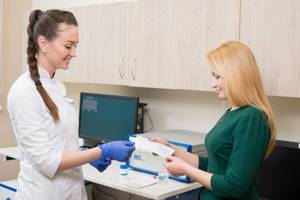
As noted above, the breath test is absolutely safe. It is widely used by gastroenterologists and therapists to conduct initial diagnosis, as well as to monitor how effective treatment is.
The essence of the breath test is to detect waste products of Helicobacter Pylori in the air exhaled by patients. There are two main breath test methods. They differ in the component that is used for the reaction.
C-urease breath test
The essence of this research method is based on the ability of the Helicobacter bacterium to produce a special enzyme - urease, which accelerates the hydrolysis of urea. This process is accompanied by the production of carbon dioxide and ammonium. People who are not infected with Helicobacter Pylori do not have urease in the stomach. In order to detect the presence of urease, the subject takes a special reagent. This is a capsule containing 75 mg of urea, labeled with either radioactive or non-radioactive carbon (C14 or C13). If Helicobacter is present in the patient’s body, after taking the reagent, hydrolysis or decomposition of urea will begin to occur, and after half an hour the patient begins to exhale vapors of ammonia and carbon dioxide, the presence of which will be detected by a special device. In this case, the test is positive. If there is no bacteria in the body, then there will be no ammonia vapors and carbon dioxide vapors in the exhaled air - the test will be negative.
The duration of the test, as a rule, does not exceed forty minutes. Moreover, subject to careful preparation for the analysis, its reliability is more than 95%. It is noteworthy that the test using radioactive carbon C14 is as safe as the test using non-radioactive C13.
Breathing Helic test
This method of identifying Helicobacter is also based on the ability of this bacterium to produce urease. This method differs from the C-urease test in that a solution containing 0.5 g of urea is used. The bacterium can provoke hydrolysis of this substance, as a result of which the quantitative content of ammonia vapor in the air exhaled by the patient increases.
Their presence is detected using a special indicator tube (in this case the color of the indicator changes) or with a digital device.
It should be borne in mind that the Helic test is less expensive, but at the same time less informative than the C-urease test. Its reliability does not exceed 75%.
How to get tested
You have decided to get tested for Helicobacter pylori. How to do this, how to prepare for analysis?

First of all, you need to know that there are several ways to do this, and it is better not to rely on one of them, but to conduct at least 2 studies. Let's give the simplest ones.
Blood analysis
Your doctor may ask you to take a blood test to see if you have antibodies to Helicobacter pylori.
For reference. Our body fights infection and produces special antibodies that bind to the pathogen to neutralize it. If the patient’s blood contains these antibodies, then we can say that he is infected.
A blood test is given in the morning, blood is collected from the cubital vein.
The preparation for it is standard, but it still doesn’t hurt to remind you about it:
- You should not take medications or drink alcohol 2 days before the test.
- Before going to the laboratory, you should not play sports or go to the bathhouse.
- Before taking the test, you should not eat fatty or spicy foods.
- You need to avoid stress, take care of yourself, and don’t get nervous.
- Blood for Helicobacter pylori analysis must be taken on an empty stomach, i.e. The last meal should be the night before. In the morning you cannot have breakfast, even drink juice, coffee or tea, or smoke.
Urease breath test
For reference. The bacterium Helicobacter pylori synthesizes urease, this is a special enzyme. It can affect urea, breaking it down into carbon dioxide and ammonia in the intestines.
When conducting a study, they look at the concentration of these substances in the exhaled air before and after taking urea.
First, the patient breathes through a special tube. There is no need to worry or worry, breathing should be the same as in normal life. After the results have been obtained, the person is asked to drink a solution of urea (5%). You must wait 5 minutes and then take the sample again.
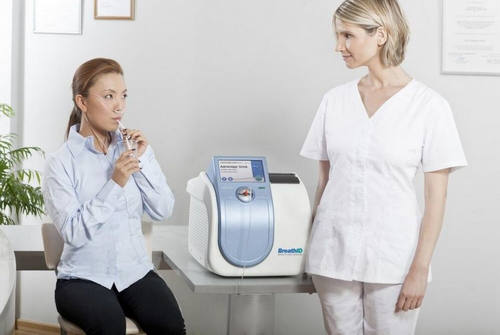
To determine whether a person is infected or not, it is necessary to check the concentration of ammonia in the exhaled air. If it is high enough (more than 0.5 mg/ml), then the test is positive. For the test to be correct, no saliva must enter the tube. If you can’t swallow it, you can sometimes pull out the tube.
In case of saliva contamination, the examination will have to be repeated.
How to prepare for the study:
- You should not take medications that reduce the acidity of gastric juice. It is worth abandoning them 3 weeks before the examination. These are antacids, antibiotics, etc.
- You will have to forget about alcoholic drinks for a while. You should not take them at least 3 days before the examination.
- The day before you go for the test, you should not eat foods that contribute to gas formation: brown bread, cabbage, peas, potatoes, etc.
- You must take the test on an empty stomach and have a light dinner beforehand.
- Before being examined, i.e. in the morning, you can’t smoke and have breakfast.
- During the day, do not chew chewing gum, which promotes strong salivation.
As we can see, preparing for the test is not difficult, but it is better to start it in advance.
Stool analysis
To determine whether the bacteria Helicobacter pylori is present in the body, you can take a stool test. Before taking stool for analysis, 3 days before you collect the material, you must give up dyes and dietary fiber, and you cannot take medications for constipation.
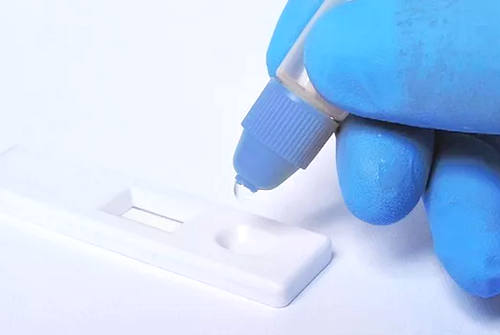
How to prepare for the analysis?
For reference. 72 hours before submitting stool for analysis, you should stop taking medications and medicinal suppositories in order for the result to be correct. A person must go to the toilet himself, without the help of laxatives. Do not stain biomaterial with urine or blood.
Feces should be stored in clean containers. It is better to go to the toilet in the morning and immediately take the stool to the laboratory. If that doesn’t work, you can do it in the evening, but the material should not be stored for more than 10 hours. And in this case, it must be kept in the refrigerator, at a temperature not exceeding 8 degrees.
How the research is carried out
The undeniable advantage of both types of breath tests is their non-invasiveness and comparative ease of implementation. They can be carried out both in a hospital setting and in a clinic.
Carrying out a C-urease breath test
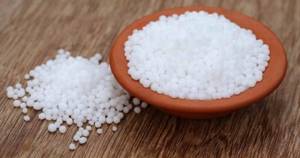
Before starting the test, the patient is asked to drink 200 ml of orange juice (in case of an allergy to oranges, it can be replaced with apple juice). The patient is then seated on a couch or chair and asked to hold his breath for a few seconds. After this, you need to exhale into a special bag. Care must be taken to ensure that no saliva gets in there.
The bag is immediately sealed, after which the patient drinks a weak urea solution labeled with carbon isotopes C13 or C14. In order for the ingested reagent to spread throughout the gastric mucosa, the patient is often asked to lie on the couch and turn first on one side, and then lie on the other.
After about half an hour, the patient is again asked to exhale into a special bag.
When using urea labeled C14, air is taken once, and if urea with C14 is used, exhaled air is taken twice, with a ten-minute interval.
The finished samples are sealed, labeled and sent to the laboratory, where they are examined using a spectroscopic or spectrophotometric method. If the air exhaled after taking urea contains hydrocarbon vapors, this indicates infection with Helicobacter Pylori.
Carrying out a Helic test
To conduct a Helic test, the patient takes a sitting position, a tube with an indicator is placed in the examinee’s oral cavity, which is connected to a special digital device. The patient breathes into the tube for 7 minutes. The results are recorded by the doctor. You need to breathe normally, without “convulsive” inhalations and exhalations. It is important that the mouthpiece does not touch either the tongue or the palate, since the slightest amount of saliva entering the tube can distort the results. If saliva does get into the indicator, the study must be started again no earlier than half an hour later. Doctors recommend that if you really want to swallow, remove the mouthpiece from your mouth for a few seconds.
At the doctor’s signal, the patient takes 0.5 g of urea dissolved in 50 ml of water. This solution is colorless and tasteless, so no unpleasant sensations arise when taking it.
After this, the patient is again asked to breathe into the tube for six minutes and the results are recorded. Next, the patient takes the solution again and repeated tests are carried out.
Since no analysis materials are delivered to the laboratory, and the data is recorded by a specialist directly at the test site, Helic test results can be obtained very quickly.



